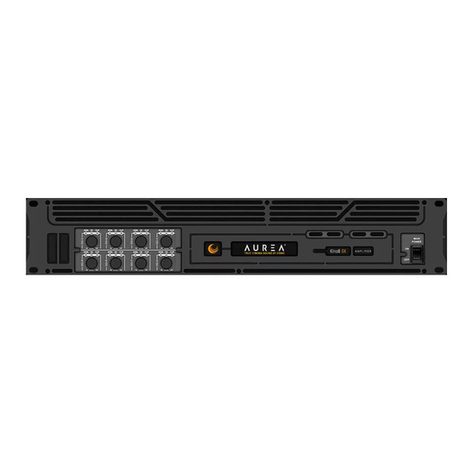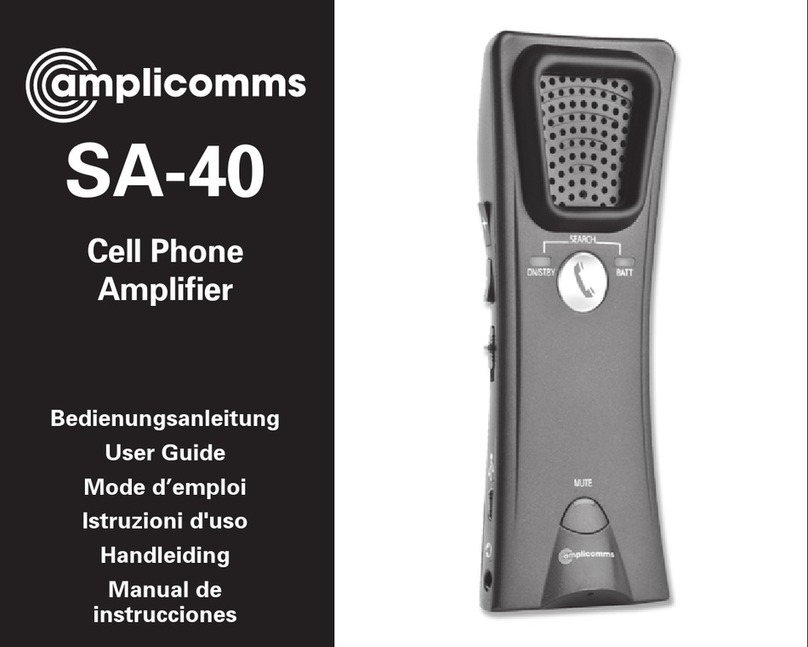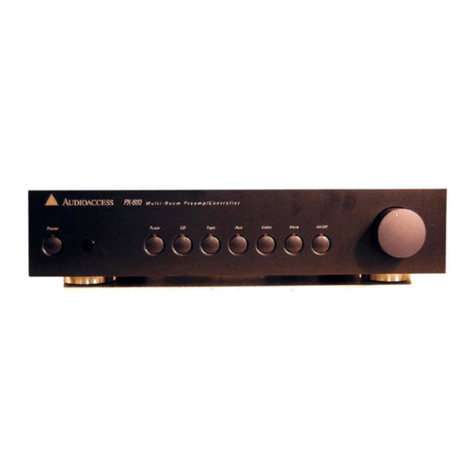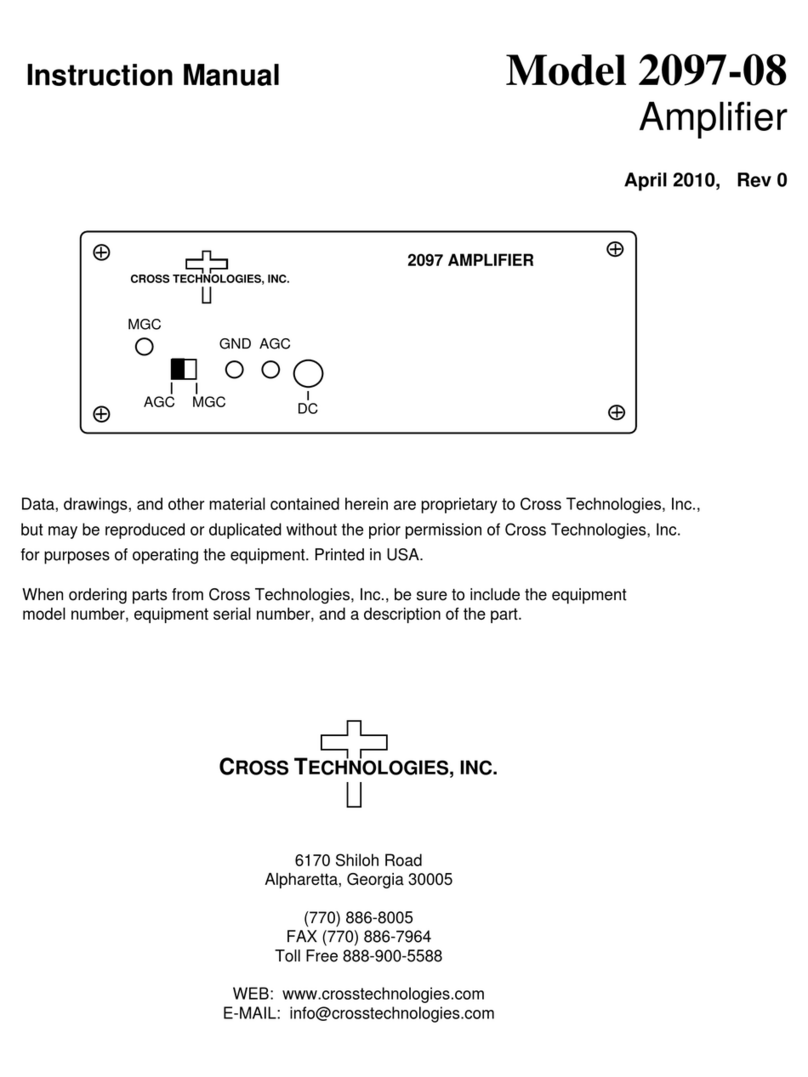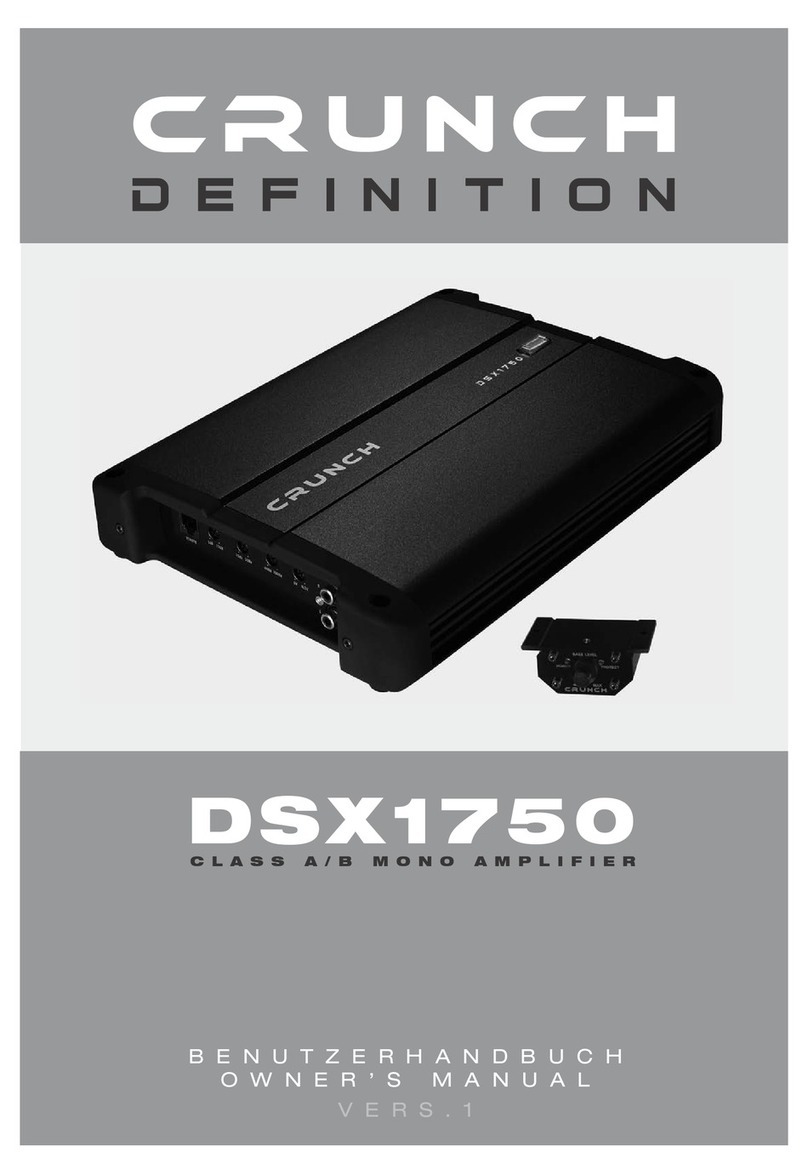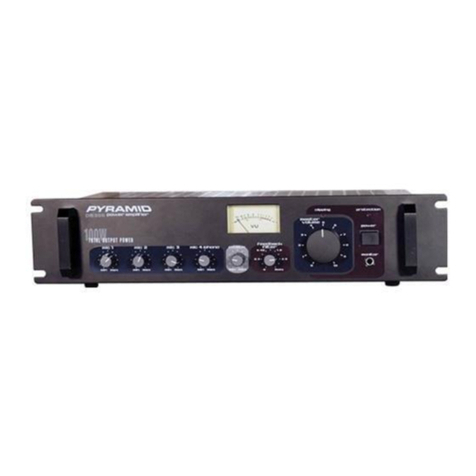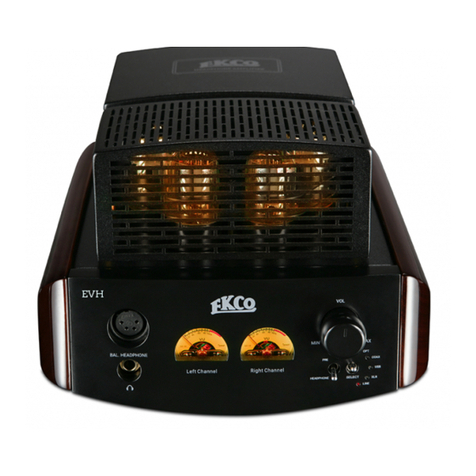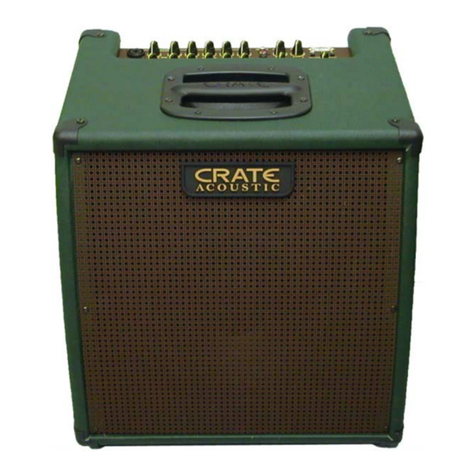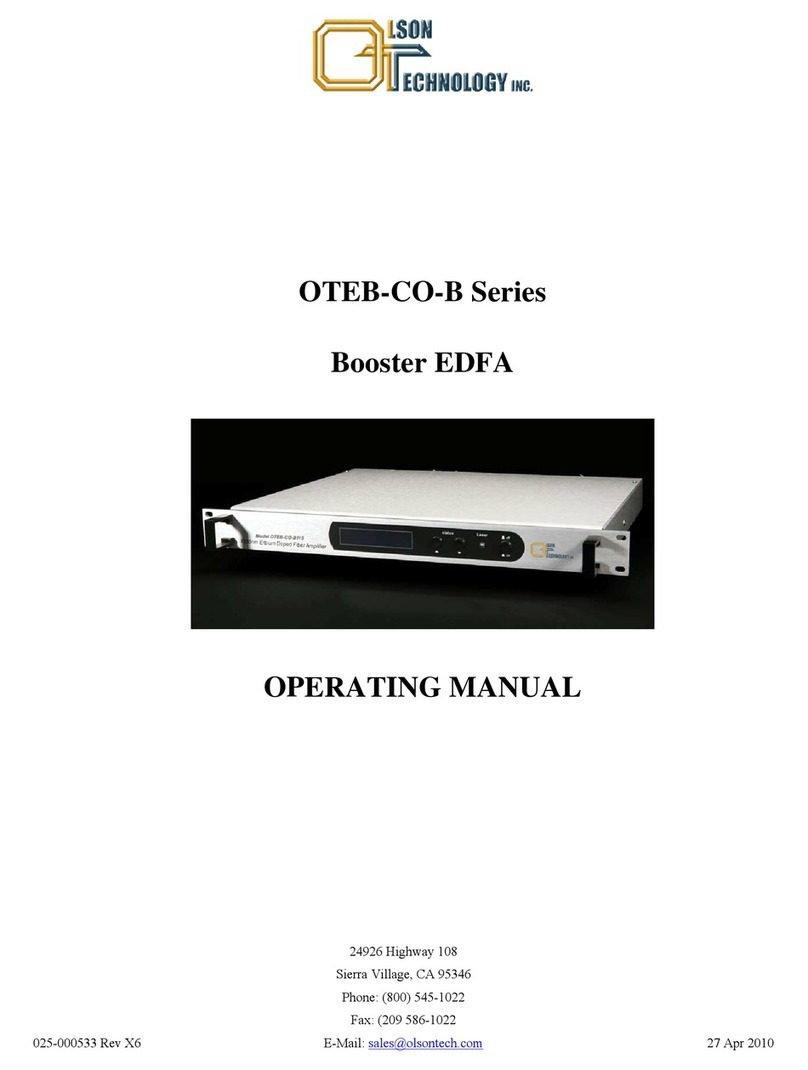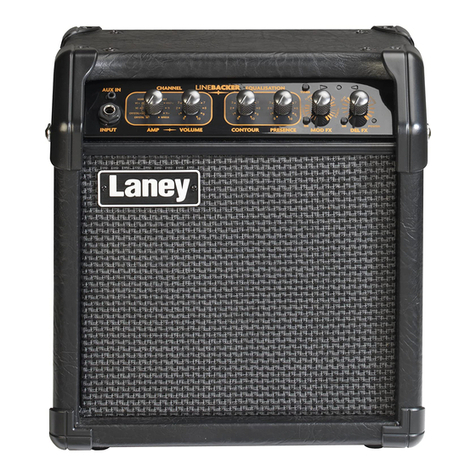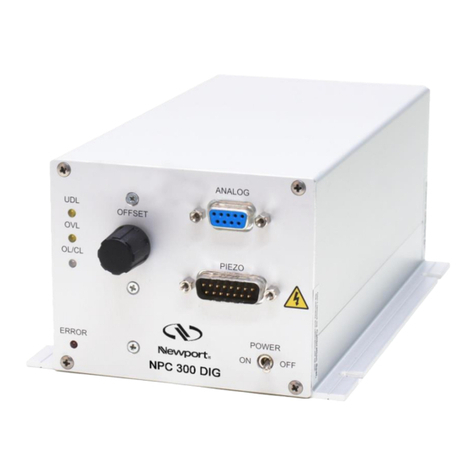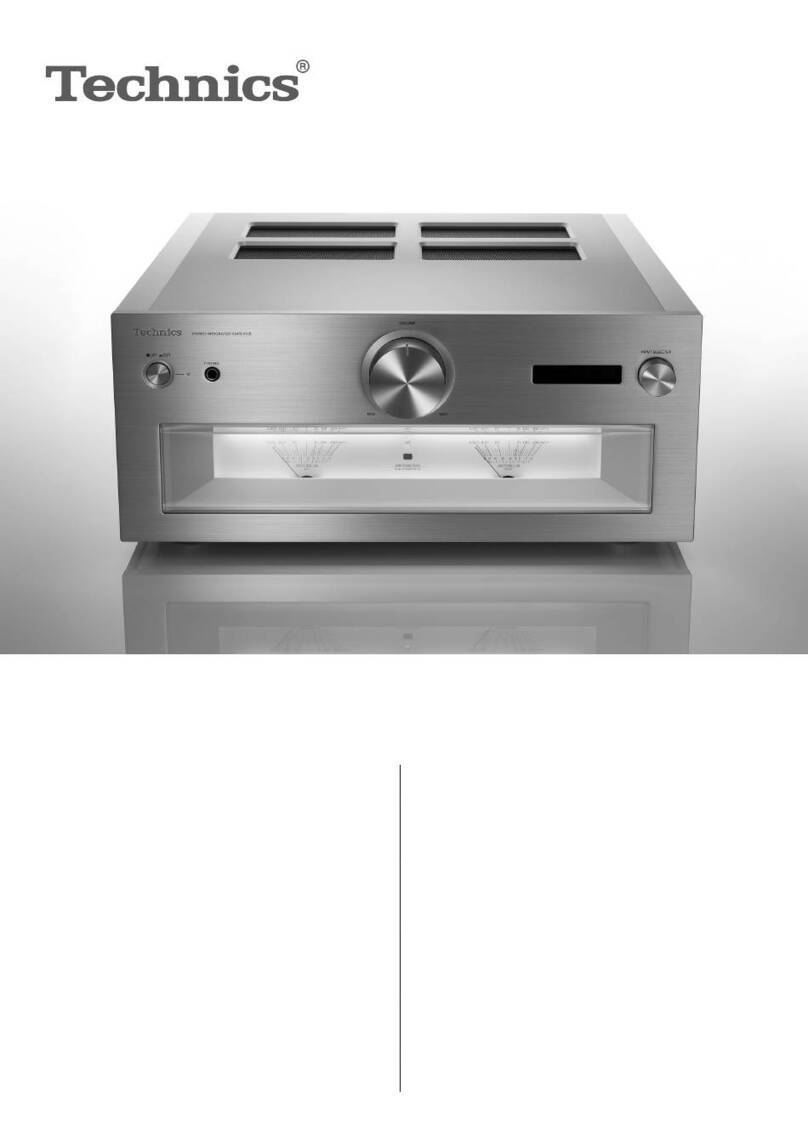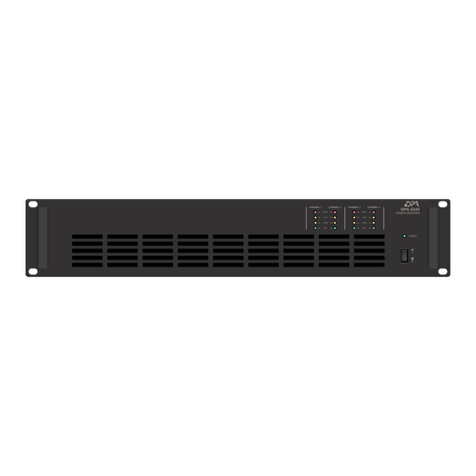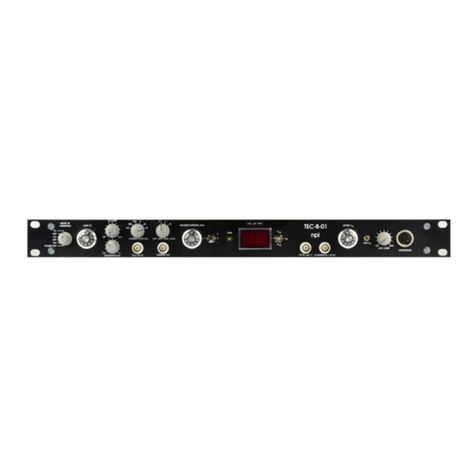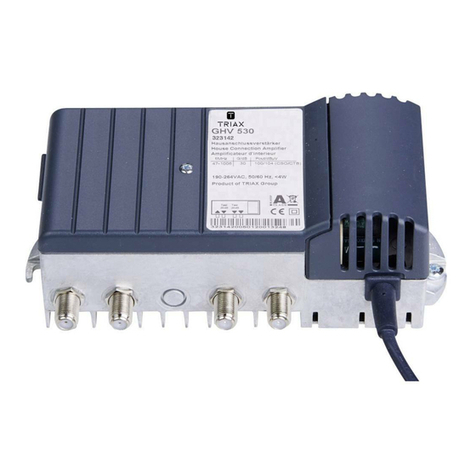Aurea T Series User manual

T Series
(Series 2)
OPERATING
INSTRUCTIONS
(DT 450/CT 160 LINE)
Proud Technology Partner of

TECHNICAL SPECIFICATION
Parameter (Units)
DT 450
CT 160
Output Power (per channel) (Watts)
8 ohms
450
160
4 ohms
750
300
2 ohms
1150
475
Output Power (bridged) (Watts)
8 ohms
1500
600
4 ohms
2300
950
THD+N: (%)(4 ohms)
@1kHz(@1dB below max output power)<
0.008
0.008
@20Hz to 20kHz(@3dB below max output power)<
0.03
0.03
Gain Options (dB)
32
32
Sensitivity Options (for maximum power) (dBu)
5.5
2
Sensitivity Options (for maximum power) (Volts)
1.4
1
Frequency Response - 20Hz to 20kHz (dB)
+0 / -0.5
+0 / -0.5
Power Consumption: Nominal @ 240v (4 ohms)(Amps)
2.8
1.5
Power Consumption: Nominal @ 120v (Amps)(4 ohms)
5.6
3
Dimensions: (mm)
Amplifier: H x W x D
88 x 482 x 460
88 x 482 x 428
Boxed (shipping UK): H x W x D
230 x 580 x 560
Boxed (shipping - all except UK): H x W x D
250 x 610 x 600
Weight: (Kgs)
Amplifier:
13.8
13.94
Boxed: (shipping)
15.34
15.8
Additional Specifications
Input Impedance - Active blanced (k ohms)
20
20
Input CMRR (dB)
>60
>60
Hum & Noise (dB below max output)
-104
-104
Damping Factor: @1kH z into 8 ohms
>400
>400
Signal Limiters - (set to prevent excessive clipping)
Yes
Yes
Protection: Shot ciruit/DC output/Temperature
Yes
Yes
Main s in rush control
Yes
Yes
Output Power (watts) into 8 ohms
Sine wave @ 1kHz
475
150
Continuouis music with Crest Factor of 2.8 (9dB)
550
160
Continuouis music with Crest Factor of 4.8 (14dB)
575
160
Continuouis music with Crest Factor of 7.8 (18dB)
625
175
Output Power (watts) into 4 ohms
Sine wave @ 1kHz
875
260
Continuouis music with Crest Factor of 2.8 (9dB)
975
260
Continuouis music with Crest Factor of 4.8 (14dB)
1025
300
Continuouis music with Crest Factor of 7.8 (18dB)
1125
300
Output Power (watts) into 2 ohms
Sine wave @ 1kHz
1375
400
Continuouis music with Crest Factor of 2.8 (9dB)
1600
460
Continuouis music with Crest Factor of 4.8 (14dB)
1750
475
Continuouis music with Crest Factor of 7.8 (18dB)
1900
600
* NOTE: DT 450, is dual channel amplifier. CT 160 is a 4-channel amplifier with 2
channels (C & D) bridgeable into 8 or 4 ohms. Channels C & D will drive into 2 ohm loads in normal 4-
channel mode. Channels A & B will not drive into 2 ohms.
Power requirements
DT 450 is fitted with an adaptable mains transformer which can be configured for nominal 115V or 230V
supplies. Internal links set these conditions.
CT 160 is fitted with either a 100/120V or 220/240V tapped transformer according to customer
requirements.

This amplifier will only operate to its very high specification if it is installed and operated as described in this
manual.
INTRODUCTION
Your T Series power amplifier is a no compromise, high quality, class AB power amplifier. There is no dynamic
switching of the audio or power rails (a very common method of achieving extra power at the expense of audio
quality) thus ensuring optimum sonic performance.
Fan speed is varied as required to keep the amplifier within its temperature limits. Signal limiters are included to
protect speakers from clipped signals.
The amplifiers include full DC and short circuit protection to ensure trouble-free service even in ‘harsher’
environments.
INSTALLATION:ELECTRICAL
The amplifier has been manufactured to comply with your local power supply requirements, but before connecting
the unit to the supply, ensure that the voltage (printed on the rear panel) is correct, and that a mains fuse of the
correct type and rating has been fitted (EXCEPT CT 160 WITH CIRCUIT BREAKER).
Make sure power outlets conform to the power requirements listed on the back of the unit. Damage caused by
connecting to improper AC voltage is not covered by the warranty.
SAFETY WARNING
This unit is fitted with a 3-wire power connector. For safety reasons, THE EARTH LEAD SHOULD NOT BE
DISCONNECTED IN ANY CIRCUMSTANCE. If ground loops are encountered consult the section on input connections
later in this manual.
WHERE A FIXED MAINS LEAD IS FITTED, THE WIRING COLOURS ARE:
230V AREAS: EARTH = GREEN AND YELLOW
NEUTRAL = BLUE
LIVE = BROWN
120V AREAS: EARTH = GREEN
NEUTRAL = WHITE
LIVE = BLACK
TO PREVENT THE LIKELIHOOD OF SHOCK OR FIRE HAZARD, DO NOT EXPOSE THE UNIT TO RAIN OR MOISTURE. DO
NOT PLACE OBJECTS CONTAINING LIQUID ON TOP OF THE APPARATUS.
TO AVOID ELECTRICAL SHOCK DO NOT REMOVE COVERS. REFER ALL SERVICING TO QUALIFIED PERSONNEL.
DO NOT USE THE UNIT IF THE ELECTRICAL POWER CORD IS FRAYED OR BROKEN. The power supply cords should be
routed so that they are not likely to be walked on or pinched by items placed upon or against them, paying particular
attention to cords and plugs and the point where they exit from the appliance.
ALWAYS OPERATE THE UNIT WITH THE AC GROUND WIRE CONNECTED TO THE ELECTRICAL SYSTEM GROUND.
Precautions should be taken so that the means of grounding of a piece of equipment is not defeated.
DO NOT REMOVE THE LID. Removing the lid will expose you to potentially dangerous voltages. There are no user
serviceable parts inside.

1. Read these instructions.
2. Keep these instructions.
3. Heed all warnings.
4. Follow all instructions.
5. Do not use this apparatus near water.
6. Clean only with a dry cloth.
7. Do not block any ventilation openings, install in
accordance with the manufacturer’s instructions.
8. Do not install near any heat sources, such as radiators,
heat registers, stoves or other apparatus (including
amplifiers) that produce heat.
9. Protect the power cord from being walked on or
pinched particularly at plugs, convenience receptacles
and the pint where they exit from the apparatus.
10. The mains circuit breaker shall remain readily
accessible.
11. Only use attachments/accessories specified by the
manufacturer.
12. Use only with the cart, tripod, bracket or table
specified by the manufacturer, or sold with the
apparatus. When a cart is used, use caution when
moving the cart/apparatus combination to avoid injury
from a tip over.
13. Disconnect this apparatus during lightning storms or
when unused for a long period of time.
14. Refer all servicing to qualified service personnel.
Servicing is required when the apparatus has been
damaged in any way, such as if the power-supply cord
or plug is damaged, liquid has been spilled or objects
have fallen into the apparatus, the apparatus has been
exposed to rain or moisture, does not operate
normally, or has been dropped.
15. Do not expose this equipment to dripping or splashing
and ensure that no objects filled with liquids, such as
vases, are placed on the equipment.
16. To completely disconnect this equipment from the AC
mains, disconnect the power cord from the mains
circuit breaker.
17. Where the amplifier is mounted in a rack and
permanently connected to the mains, then the rack
should be installed with a readily accessible connector
or an ALL POLE circuit breaker with 3mm breaking
distances.
18. This unit is fitted with a 3-wire power cord. For safety
reasons, THE EARTH LEAD SHOULD NOT BE
DISCONNECTED IN ANY CIRCUMSTANCE.
19. The cooling fans suck cool air in through the front and
blow hot air out at the rear of the unit through the
ventilating grills. The front and rear of the amplifier
should have free exposure to the air (i.e. in a rack
leave the front and rear doors off), with 2cm air gap at
the sides and top. IF AIR IS NOT ALLOWED TO
ESCAPE FROM THE REAR, OVER-HEATING WILL
OCCUR. Take care when mounting other equipment in
the same rack.
20. The mains switch on the amplifiers only switches one
pole of the mains supply, therefore for units with a
detachable cord to be fully disconnected from the
mains, the mains disconnect device (ie mains plug or
mains coupler) should remain readily operable. For
units with a fixed mains lead the external all pole
circuit breaker with 3mm breaking distances is the
disconnect device and therefore the installation of the
amplifier shall be carried out in accordance with all the
applicable installation rules.
WARNING: Apparatus with CLASS I construction shall be connected to a MAINS socket outlet with a protective
earthing connection.
WARNING: To prevent injury, this apparatus must be securely attached to the rack in accordance with the installation
instructions.

INSTALLATION: MECHANICAL
To ensure that this equipment performs to specification, it should be mounted in a suitable rack or enclosure as
described below. Like all high power amplifiers, it should be kept away from other equipment which is sensitive to
magnetic fields. Also, this amplifier may suffer a substantial reduction in performance if it is subjected to, or mounted
close to equipment which radiates high R.F. fields.
When mounting the amplifier in a rack or enclosure, ensure that :-
1. The rear of the unit is adequately supported. The brackets which are supplied fit standard 19 inch
(483mm) rack mounting systems. THE FRONT PANEL IS NOT CAPABLE OF SUPPORTING THE UNIT ON ITS OWN.
2. THERE IS ADEQUATE VENTILATION. The cooling fans suck cool air in through the front and blow hot air out at the
rear of the unit through the ventilating grills. IF THIS AIR IS NOT ALLOWED TO ESCAPE, OVERHEATING WILL OCCUR.
Take care when mounting other equipment in the same rack.
ALSO SEE MAINTENANCE SECTION.
CONNECTIONS
INPUTS
The inputs are made via 3-pin XLR connectors, which are electronically balanced and should be connected via a high
grade twin core screened cable, as follows :-
PIN1 - Screen (see note)
PIN2 - Hot (signal +)
PIN3 - Cold (signal -)
The amplifier is designed to operate with fully balanced equipment and ground loops or loss of performance may be
experienced if connected to unbalanced sources. If it is unavoidable however, the following wiring should be used.
The cable should still be twin core plus screen.
PIN1 - Screen - connected to the chassis of the unbalanced equipment - or left disconnected at the unbalanced
end.
PIN2 - Signal Hot
PIN3 - Signal Cold
NOTE: This amplifier is wired to the latest industry recommendations. PIN1 is connected directly to the
chassis/mains earth. If ground loops (mains hum) are encountered remove the screen connection
from the other end of the cable and leave it open circuit. If problems persist, consult your dealer/
supplier, DO NOT TAMPER WITH OR ALTER ANY GROUND (EARTH) CONNECTIONS
INSIDE THE AMPLIFIER.
For bridged operation input should be made to channel A only and the rear panel switch set for bridged mode.
Channel B will then be fed out of phase with channel A.
OUTPUTS
The speaker outputs are via Neutrik Speakon connectors. 2 pole (NL2FC) or 4 pole (NL4FC) connectors can be used.
1 - Terminations are as follows :- HOT Pin +1
COLD Pin -1

2 - Additionally Channel A Speakon connector carries Channel B output on Pins +2 & -2 to allow easy bi-amping or
bridged operation. HOT Pin +2
COLD Pin -2 CONFIGURATION 2 DOES NOT APPLY TO CT 160
(See also Bridged operation)
NOTE: 1. There must be no shared connections between channels.
NOTE: 2. Because the currents involved are very high, the speaker cables should conform to the following
minimum requirements, otherwise the losses will cause the cables to get hot and audio power will
be reduced:
NOTE: Do not connect the inputs/outputs to any other voltage source such as a battery, mains source
or
power supply, regardless of whether the amplifier is turned on or off.
Do not run the output of any amplifier channel back into another channel’s input and do not
parallel or series-connect an amplifier output with any other amplifier output.
BRIDGED (MONO) OPERATION (DT 450)
Supply the signal to Channel A input only & push in the rear panel switch marked 'Bridged Mono'
Use Channel A Output Speakon connector and connect as follows:
HOT Pin +2
COLD Pin -1
BRIDGED (MONO) OPERATION (CT 160)
Use centre Speakon connector marked ‘BRIDGED’ and connect as follows:
HOT Pin +1 (Channel C - IN PHASE)
COLD Pin -1 (Channel D - OUT OF PHASE)
When operating in bridged mode, the minimum impedances are doubled. The minimum load in bridged
mode is: DT 450: 4 ohms, CT 160: (Ch C & D only): 4 ohms.
LINK SOCKET
Each channel is provided with a 3-pin XLR connector marked ‘LINK’ which allows the input signal to be linked to
further amplifiers etc. The connections are the same as for the input XLR.
OPERATION
Read all documentation before operating your equipment and retain all documentation for future reference.
Do not spill water or other liquids into or on the unit and do not operate the unit while standing in liquid.
Do not block fan intake or rear ventilation outlets or operate the unit in an environment which could impede the free
flow of air around the unit.
If the unit is used in an extremely dusty or smoky environment, it should be cleaned of any collected debris at regular
intervals. (See Maintenance section.)

It is important that the power output of your amplifier is matched to the power handling capacity of your
loudspeaker. If not, damage to the loudspeaker could occur.
SWITCHING ON
At ‘switch-on’ the protection circuit will initially activate whilst the circuits stabilise. Assuming no faults are detected
after a few seconds only the ‘POWER’ LED (and ‘SIGNAL’ indicators if signal is applied) will illuminate.
PANEL CONTROLS AND INDICATORS
Level controls
These are analogue controls allowing precise level settings. Note that in ‘BRIDGED’ mode only ‘channel A’ control is
active.
Signal Indicators (blue LED)
These are active from a minimum output level of approximately 1 Watt and are an indication only of signal presence.
Limiters (amber LED)
The T Series amplifiers incorporate signal limiters, which are preset to prevent clipping with high levels of drive.
The amber LEDs on the front panel illuminate to indicate operation of the limiters.
Temperature Control
The cooling fans respond to temperature sensors within the unit to maintain a safe operating temperature. In the
event of excessive temperature, the protection circuit will operate, disabling the output. The red Audio-Protect
(A/P) LED will indicate this condition (see fault indicator).
On the DT 450 there are two cooling fans. The second (rear) fan can be set to only work when the temperature
exceeds 90°C. A jumper link (JF3) is normally set to permanently enable FAN2 so that it varies in speed, proportional
to temperature in conjunction with FAN1.
The CT 160 has two fans with variable speed and a jumper link to enable them from cold.
Normal dynamic signals will not cause the amplifier to overheat unless the ventilation is inadequate. (See
installation section and maintenance section.)
Fault Indicator (Audio Protection – red LED)
If the outputs are shorted or if DC is present, the protection circuit will disengage the outputs and the A/P LED will
illuminate. The amplifier will continue to be monitored and depending on the type of fault, will either reset after the
fault has cleared or require manual resetting by switching off at the mains switch and then on again after a few
seconds. (See also temperature control above )
Temperature related faults will reset once the unit has cooled sufficiently.
Output short circuits will require manual reset after clearing the fault.
Bridged LED (green)
This indicates the position of the switch on the rear panel and is illuminated when bridged mode is selected with the
switch pressed in.

100V LINE OPERATION
When using the T Series with ‘line’ transformers, it is recommended that the frequency response is altered to
prevent saturation of the transformer core with large signals. This could trigger a fault condition since it would be
seen by the amplifier protection circuit as a short circuit on the output.
The CT 160 should be fitted with a suitable cross-over card set to roll off the LF response to be -3dB @ 63Hz.
The DT 450 can also be fitted with a cross-over card but they also have single filters built-in for this purpose. There
are 4 black jumper links marked as HPF and when links are removed the frequency response is modified for 100V line
operation.
For normal operation, all 4 links should be fitted.
MAINTENANCE -(ENSURE THAT ELECTRICAL POWER TO THE UNIT IS DISCONNECTED BEFORE
CARRYING OUT ANY MAINTENANCE.)
The filter behind the air intake apertures on the front of T Series amplifiers should be cleaned or replaced
periodically, e.g. 12-24 months. (Filters in amplifiers located in more 'dirty' atmospheres may require more frequent
maintenance). The filter should be 'dry' cleaned, using a vacuum cleaner preferably. Running the unit without a filter
is not recommended unless it is within a 'clean room'. Replacement filter material is available.
No other regular maintenance is required.
If you have any doubt about carrying out this procedure, refer to a service engineer or contact your dealer.
IF YOUR AMPLIFIER DEVELOPS A FAULT, PLEASE REFER TO YOUR SUPPLIER FOR SERVICE AND TECHNICAL SUPPORT.
DO NOT ATTEMPT TO REPAIR THE FAULT YOURSELF AS THIS WILL INVALIDATE THE WARRANTY.

PENDIX I
DT LINE - OPERATING INSTRUCTIONS
The DT Line chassis can be configured with up to 4 transformers, which can be any mix of the available types: 250W,
500W, 750W at 100V output, 4 ohms input. Other specifications (70V/50V) are available to special order.
The power rating of each channel is printed on the rear panel.
The connections are via 4-pole SPEAKON connectors (NL4FC).
INPUTS (4 ohms) are: +1 = HOT, -1 = COLD
OUTPUTS (100V) are: +2 = HOT, -2 = COLD
THERE ARE NO USER-SERVICEABLE PARTS INSIDE AND NO MAINTENANCE IS REQUIRED.
IN THE EVENT OF A FAILURE, REFER TO A QUALIFIED SERVICE ENGINEER.
TECHNICAL SPECIFICATION
DT LINE
Rated power handling 250W 500W 750W
@ input impedance - 4
Output impedance rated @ 100V 40.020.013.3
70V 19.69.86.5
50V 10.0 5.03.3
Frequency response 50Hz-16kHz ± 1dB
Distortion (THD) 50Hz-16kHz <0.03%
Weight (each) Chassis only 12kgs
250W transformer 2.3kgs
500W transformer 2.8kgs
750W transformer 4.4kgs
Dimensions (mm) - 2U 88 x 482 x 428
When mounting the amplifier in a rack or enclosure, ensure that :-
The rear of the unit is adequately supported. The brackets which are supplied fit standard 19 inch (483mm) rack
mounting systems. THE FRONT PANEL IS NOT CAPABLE OF SUPPORTING THE UNIT ON ITS OWN.
(The general T Series safety warnings, precautions and service advice also apply to the DT LINE.)

APPENDIX II
Instructions for using 'DT' series amplifiers with 100V/70V line transformers
Frequency response
It is necessary to provide some low frequency roll off to prevent the possibility of the line transformer saturating.
On the CD 160 we recommend using an crossover filter PCB – XO5 (each XO5 card handles 2 channels) normally set
to a crossover frequency of 63 Hz. The roll off is normally at 24dB per octave.
On the DT 450 the roll off is included on the main board as standard. To bring the 63 Hz roll off into circuit, remove
the 4 jumper links at 'hpf'.
The response must be at least -3dB at 70 Hz and roll off at minimum 12dB per octave.
LINE TRANSFORMER LEAD OUTS
250W and 500W single 100V winding:
Primary: Orange = +ve, Black = -ve (4 ohms)
Secondary: Yellow = +ve, Grey = -ve (100V)
Blue = centre tap, for monitoring purposes only
750W dual secondary 50V + 50V:
Primary: Orange = +ve, Black = -ve (4 ohms)
Secondary 1: Yellow = +ve, Blue = -ve (50V)
Secondary 2: Green = +ve, Grey = -ve (50V)
This manual suits for next models
2
Table of contents
Other Aurea Amplifier manuals
